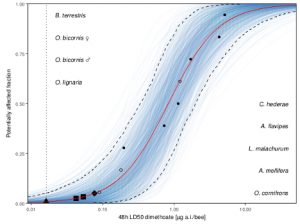In this post, Philipp Uhl and colleagues talk about their recently published paper “Interspecific sensitivity of bees towards dimethoate and implications for environmental risk assessment”.

Species sensitivity distribution of dimethoate calculated from multiple bee species’ sensitivity (Uhl et al. 2016)
Bees are important pollinators that are essential to achieve adequate yield in numerous crops. Nowadays, wild and domesticated bee species are affected by multiple environmental factors which drive their decline. Pesticides are one potential cause amongst other factors such as parasites and habitat loss. The honey bee is included as a test species in EU pesticide risk assessment as the only pollinator species. It was proposed by the European Food Safety Authority (EFSA) that solitary and bumble bee species should also be tested due to substantial differences to the honey bee in their ecological profiles and a general lack of information on interspecific bee sensitivity. They recommended two new test species for risk assessment: The buff-tailed bumble bee Bombus terrestris and the red mason bee Osmia bicornis.
We conducted acute contact toxicity tests with multiple bee species to determine median lethal doses (LD50) of the organophosphate insecticide dimethoate. Furthermore, we generated a species sensitivity distribution (SSD) and derived a hazardous dose (HD5). Moreover, we performed a regression analysis with body weight and dimethoate toxicity. HD5 lower 95% confidence limit was equal to honey bee mean LD50 when applying a safety factor of 10. Bombus terrestris and Osmia bicornis were the least sensitive of all tested species. Body weight proved to be a predictor of interspecific bee sensitivity but did not explain the pattern completely.
Using acute toxicity values from honey bees and a safety factor of 10 seems to cover the interspecific sensitivity range of bees in the case of dimethoate. Acute endpoints of the two proposed additional test species do not improve the risk assessment for bees. However, this might not apply to other insecticides such as neonicotinoids.
This article was authored by Philipp Uhl, Lea Franke, Christina Rehberg, Claudia Wollmann, Peter Stahlschmidt, Lukas Jeker and Carsten Brühl and is published in Scientific Reports.
